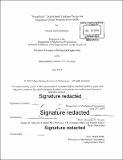| dc.contributor.advisor | Alexander H. Slocum. | en_US |
| dc.contributor.author | Bockman, Samuel Jacob. | en_US |
| dc.contributor.other | Massachusetts Institute of Technology. Department of Mechanical Engineering. | en_US |
| dc.date.accessioned | 2019-12-13T18:57:53Z | |
| dc.date.available | 2019-12-13T18:57:53Z | |
| dc.date.copyright | 2019 | en_US |
| dc.date.issued | 2019 | en_US |
| dc.identifier.uri | https://hdl.handle.net/1721.1/123255 | |
| dc.description | Thesis: S.B., Massachusetts Institute of Technology, Department of Mechanical Engineering, 2019 | en_US |
| dc.description | Cataloged from PDF version of thesis. | en_US |
| dc.description | Includes bibliographical references (page 42). | en_US |
| dc.description.abstract | Invasive floating sargassum seaweed has become a serious problem for Caribbean nations due to the blocking of fisheries and distinct rotten smell that disincentivizes tourism to these countries. The solution to this problem conceived in Luke Gray's master's thesis was to pump the sargassum to a depth where the hydrostatic pressure is sufficiently greater than the sargassum bladder internal pressure such that the bladders are compressed, and the plant sinks [1]. This would be achieved by feeding a mixture of sargassum and seawater through a suction hose to an onboard solids pump, which then transports the sargassum to a depth where the hydrostatic pressure renders the sargassum negatively buoyant. One inlet device, discussed in Gray's thesis, is called the "sump-inlet" which operates much like an oil skimmer, controlling and enforcing a high solids concentration by locating a weir close to the free surface of the water. Once sargassum and seawater flows over the weir, into the sump, the sargassum is dragged downward toward suction piping, against its natural rate-of-rise, due to the constrained cross-sectional area of the sump and the high downward fluid velocity. With this method chosen, a single DOF linkage system was needed to deploy the sump-inlet and constrain it during operation. The hydrodynamic response of this linkage must ensure that the weir stays at an acceptable depth, in as wide a range of sea states as possible, to avoid inconsistent solids concentration and dry-running. Dimensions and mass properties of the sump-inlet linkage were informed by Gray's hydrodynamics model [1]. This thesis focuses on structural analysis of the deployment linkage, deck frame, attachments, and pivot. | en_US |
| dc.description.statementofresponsibility | by Samuel Jacob Bockman. | en_US |
| dc.format.extent | 42 pages | en_US |
| dc.language.iso | eng | en_US |
| dc.publisher | Massachusetts Institute of Technology | en_US |
| dc.rights | MIT theses are protected by copyright. They may be viewed, downloaded, or printed from this source but further reproduction or distribution in any format is prohibited without written permission. | en_US |
| dc.rights.uri | http://dspace.mit.edu/handle/1721.1/7582 | en_US |
| dc.subject | Mechanical Engineering. | en_US |
| dc.title | "Sump-Inlet" deployment linkage design for sargassum ocean sequestration (SOS) | en_US |
| dc.type | Thesis | en_US |
| dc.description.degree | S.B. | en_US |
| dc.contributor.department | Massachusetts Institute of Technology. Department of Mechanical Engineering | en_US |
| dc.identifier.oclc | 1130060687 | en_US |
| dc.description.collection | S.B. Massachusetts Institute of Technology, Department of Mechanical Engineering | en_US |
| dspace.imported | 2019-12-13T18:57:53Z | en_US |
| mit.thesis.degree | Bachelor | en_US |
| mit.thesis.department | MechE | en_US |
